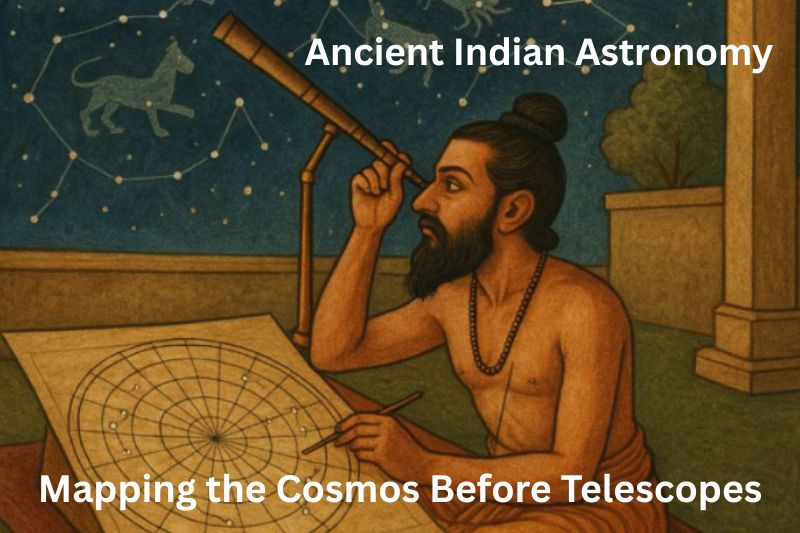Introduction
Ancient Indian Astronomy: Long before the invention of telescopes, ancient Indian astronomers meticulously observed the heavens, developing sophisticated mathematical models and cosmological theories. Their contributions laid the foundation for modern astronomy, influencing civilizations from the Islamic world to Europe. This blog explores the remarkable achievements of Vedic and Siddhantic astronomy, highlighting key texts, scholars, and instruments that shaped India’s celestial legacy.
With references from Rigveda, Aryabhatiya, Surya Siddhanta, and other seminal works, we uncover how India’s astronomers calculated planetary motions, predicted eclipses, and even proposed a heliocentric model centuries before Copernicus.
1. The Vedic Foundations of Indian Astronomy (1500–500 BCE)
Celestial Observations in the Rigveda
The Rigveda, one of the world’s oldest texts (circa 1500 BCE), contains some of the earliest astronomical references:
- 27 Nakshatras (Lunar Mansions): Used for timekeeping and astrology .
- Solar & Lunar Cycles: The Sun (Surya) and Moon (Chandra) were studied for seasonal and ritual calendars .
- Eclipse Predictions: Descriptions of Rahu and Ketu (shadow planets) explain eclipses mythologically .
Vedanga Jyotisha: The First Astronomical Manual
Compiled by Lagadha, this text (1000–500 BCE) systematized astronomy for rituals, introducing:
- Luni-solar calendars aligning agricultural and religious events .
- Time measurement from sunrise to sunrise, akin to modern days .
2. The Golden Age: Siddhantic Astronomy (500–1200 CE)
Aryabhata’s Revolutionary Theories (476–550 CE)
In his Aryabhatiya, Aryabhata proposed:
- Earth’s Rotation: The apparent movement of stars is due to Earth spinning on its axis .
- Heliocentrism: Suggested the Sun as the center, predating Copernicus by a millennium .
- Trigonometry & Pi (π): Calculated π as 3.1416 and introduced sine functions .
Varahamihira’s Pancha-Siddhantika (505–587 CE)
A synthesis of Indian, Greek, and Babylonian astronomy, this text covered:
- Planetary positions and eclipse calculations .
- Atmospheric science, linking celestial events to weather patterns .
Brahmagupta & Bhaskara II: Refining Celestial Mechanics
- Brahmagupta (598–668 CE): In Brahmasphutasiddhanta, he described gravity:
“Objects fall towards the Earth as it is in the nature of the Earth to attract.” .
- Bhaskara II (1114–1185 CE): Advanced calculus for planetary motion in Siddhanta Shiromani .
3. Instruments & Observational Techniques
Jantar Mantar: The Stone Observatories
Built by Maharaja Jai Singh II (18th century), these structures included:
- Samrat Yantra: A 27-meter sundial accurate to 2 seconds .
- Jaiprakash Yantra: For tracking celestial coordinates .
Ancient Tools Before Telescopes
- Gnomon (Shanku): Measured solar angles and time .
- Water Clocks (Ghatika Yantra): For precise timekeeping at night .
4. Influence on Global Astronomy
Transmission to the Islamic World & Europe
- Arabic scholars like Al-Khwarizmi translated Brahmagupta’s works, introducing zero and algebra .
- Copernicus & Kepler were possibly influenced by India’s heliocentric ideas .
Legacy in Modern Science
- NASA’s acknowledgment of Surya Siddhanta’s planetary calculations .
- Trigonometric functions from India underpin space missions today .
5. Comparative Analysis in Ancient vs. Modern Astronomy
Key Findings from Recent Research (2024):
- Ancient Indian Astronomy: The Rigveda (1500 BCE) and Surya Siddhanta (4th–5th century CE) documented sidereal calculations, eclipse predictions, and a proto-heliocentric model. Modern astronomy validates these using computational models, though ancient methods lacked telescopic precision .
- Modern Validation: NASA’s ephemeris data aligns with Aryabhata’s planetary motion equations (5th century CE), confirming India’s early advancements in celestial mechanics .
Gaps Identified: Ancient texts blended mythology with science (e.g., Rahu-Ketu eclipses), while modern astronomy relies on empirical data and instrumentation.
Comparative Analysis: Ancient vs. Modern Astronomy
Key Findings (2024 Research)
| Aspect | Ancient Indian Astronomy (Pre-Telescope) | Modern Astronomy |
|---|---|---|
| Planetary Motion | Aryabhata’s equations (5th century CE) | NASA’s ephemeris |
| Eclipse Prediction | Rahu-Ketu model (symbolic + math) | Gravitational models |
| Tools | Gnomon, water clocks | Telescopes, satellites |
6. Debates & Misconceptions
Myth vs. Science
- Vedic cosmology describes a multi-layered universe, blending philosophy with astronomy .
- Critics argue some theories were symbolic, but mathematical rigor proves advanced science .
Lost Texts & Rediscoveries
- The Aryabhata Codex, a 10th-century manuscript, reveals advanced calculus .
Conclusion: Why Ancient Indian Astronomy Matters Today
From zero to heliocentrism, India’s astronomers shaped global science. Their observational precision and mathematical genius remain relevant in astrophysics and space exploration.
- Academic Sources: Aryabhatiya (499 CE), Brahmasphutasiddhanta (628 CE), Pancha-Siddhantika
Also Read –

2 thoughts on “Ancient Indian Astronomy: Mapping the Cosmos Before Telescopes”